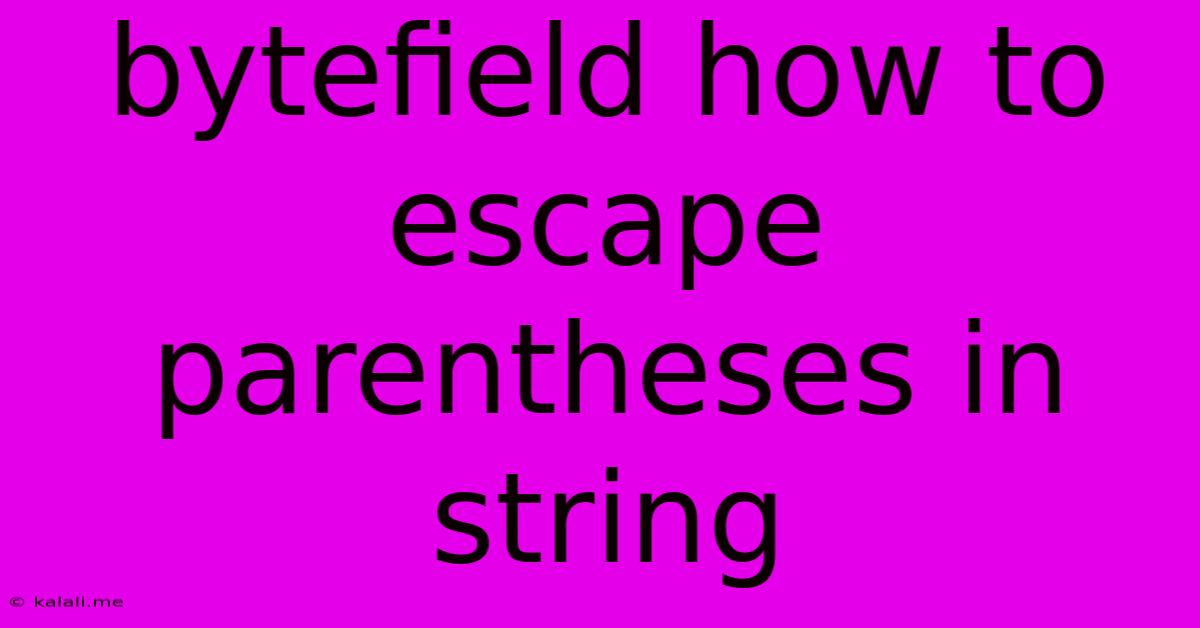Bytefield How To Escape Parentheses In String
Kalali
Jun 05, 2025 · 3 min read

Table of Contents
Escaping Parentheses in Bytefield Strings: A Comprehensive Guide
Meta Description: Learn how to properly escape parentheses in Bytefield strings, avoiding common pitfalls and ensuring your data integrity. This guide covers various programming languages and scenarios.
Parentheses, while essential for grouping and defining structures in many programming contexts, can present challenges when embedded within strings, particularly when dealing with bytefields or binary data. This is because parentheses often hold special meaning within the parsing or interpretation of these data structures. This guide will walk you through effective methods for escaping parentheses in Bytefield strings, ensuring your data remains accurate and your code functions correctly.
Understanding the Problem
The issue arises when you need to store or transmit literal parentheses ( and ) as part of your bytefield string. Without proper escaping, the parser might interpret these parentheses as part of the bytefield's structure rather than as literal characters within the data itself. This leads to errors in data interpretation and processing.
For example, let's imagine a bytefield representing a structured data packet with fields enclosed in parentheses: (field1:value1)(field2:value2). If the parser encounters these parentheses without proper escaping, it will likely misinterpret the data structure, leading to incorrect parsing of the fields.
Escaping Techniques: Language-Specific Approaches
The method for escaping parentheses varies slightly depending on the programming language and the specific bytefield library being used. Here are some common approaches:
1. Using backslashes (\):
Many languages support using a backslash as an escape character. A backslash before a parenthesis tells the parser to treat it as a literal character, not a structural element.
- Example (Python):
bytefield_string = r"\(field1:value1\)\(field2:value2\)" # Raw string literal prevents Python from interpreting backslashes
The r prefix before the string literal creates a raw string in Python, preventing the backslash from being interpreted as an escape character within the string itself. This ensures the backslashes are included in the final string.
2. Using alternative delimiters:
Some bytefield libraries or parsing techniques might allow the use of alternative delimiters for field separation. If parentheses are causing problems, consider switching to a different character (like commas, semicolons, or even custom delimiters) to avoid escaping altogether. This simplifies the string and avoids potential errors stemming from escape character handling.
3. Hexadecimal or Base64 Encoding:
For increased robustness and portability, consider encoding the entire bytefield string using hexadecimal or Base64 encoding. This removes any ambiguity concerning special characters like parentheses, ensuring that they are transmitted and stored accurately. Decoding is necessary to retrieve the original string later.
- Example (Conceptual):
The string (field1:value1) could be encoded to a hexadecimal representation, eliminating any concerns about special character interpretation during transmission or storage. The decoding process would then restore the original string.
Best Practices
- Consistency: Choose one escaping method and use it consistently throughout your codebase.
- Documentation: Clearly document your chosen escaping method in your code comments.
- Testing: Thoroughly test your code to ensure that escaped parentheses are handled correctly.
- Library Documentation: Always refer to the documentation for your specific bytefield library or parser for any language-specific guidelines on escaping special characters.
Conclusion
Escaping parentheses in Bytefield strings is crucial for accurate data handling. By understanding the potential issues and employing the appropriate escaping techniques—whether using backslashes, alternative delimiters, or encoding—you can ensure the integrity of your data and avoid unexpected errors in your programs. Remember to choose a method suitable for your chosen programming language and bytefield library, and always test your code thoroughly.
Latest Posts
Latest Posts
-
Realm Bilbo Enter When Putting On The Ring
Jun 06, 2025
-
What Is It Called When Someone Sets Up 2 People
Jun 06, 2025
-
Off Grid Shower Gray Water Tank
Jun 06, 2025
-
Hiq Do I Fix Broken Meshes In Blender
Jun 06, 2025
-
What To Do With Old Checks
Jun 06, 2025
Related Post
Thank you for visiting our website which covers about Bytefield How To Escape Parentheses In String . We hope the information provided has been useful to you. Feel free to contact us if you have any questions or need further assistance. See you next time and don't miss to bookmark.